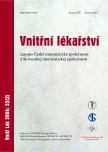Medical device „Task Force Monitor“ in diagnostics of syncope by means of head-up tilt table testing
Authors:
J. Siegelová 1; B. Fišer 2
Authors‘ workplace:
Klinika funkční diagnostiky a rehabilitace Lékařské fakulty MU a FN u sv. Anny, Brno, přednosta prof. MUDr. Jarmila Siegelová, DrSc.
1; Fyziologický ústav Lékařské fakulty MU, Brno, přednosta prof. MUDr. Bohumila Fušer, CSc.
2
Published in:
Vnitř Lék 2006; 52(2): 160-166
Category:
Review
Overview
Head-up tilt table testing is used for diagnostics of vasovagal syncope. Beat-to-beat blood pressure recording and ECG monitoring is not sufficient for clarification of the syncope mechanisms in individual patients however. That is why a Force Task Monitor was developed in Graz, Austria. In addition this device enables stroke volume by impedance Method recording. Other advantages are calculations of cardiac output, beat-to-beat total peripheral resistance, heart rate variability and baroreflex sensitivity as well as activity of sympathicus and parasympathicus assessment. These methods enable detailed hemodynamic analysis during the whole head-up tilt testing duration, the moment of syncope including.
Key words:
vasovagal syncope - head-up tilt table testing - Task Force Monitor - heart rate variability - baroreflex sensitivit
Sources
1. Perry WS, Kenny RA, Tilt table testing. In: Malik M (ed). Clinical guide to cardiac autonomic tests. Netherlands: Kluwer Academic Publisher 1999 : 67-99.
2. The Task Force on Syncope, European Society of Cardiology. Guidelines on management (diagnosis and treatment) of syncope - update 2004. Europ Heart J 2004; 25 : 2054-2072.
3. ESC Guidelines. Guidelines on management (diagnosis and treatment) of syncope - update 2004. Europace 2004; 6 : 467-537.
4. Committee for practical Guidelines to improve the quality of clinical practice and patient care in Europe. Syncope. European Society of Cardiology, 2005; 1-16.
5. Peňáz J. Photoelectric Measurement of Blood Pressure, Volume and Flow in the Finger. Dresden: Digest of the 10th international conference on medical and biological engeneering 1973 : 104.
6. Dvořák R, Kozák M, Semrád B. Přínos a postavení HUT testu (head upright tilt test) u nemocných se synkopou nejasné etiologie. Vnitř Lék 1994; 40(12): 760-764.
7. Sutton R, Petersen M, Brignole M et al. Proposed classification for tilt induced vasovagal syncope. Eur J Card Pacing Electrophys 1992; 3 : 180-183.
8. Placheta Z, Siegelová J, Štejfa M et al. Zátěžová diagnostika v ambulantní a klinické praxi. Praha: Grada Publishing 1999 : 276.
9. The Consensus Committee of the American Autonomic Society and the American Academy of Neurology. Consensus statement on the definition of orthostatic hypotension, pure autonomic failure and multiple system athrophy. Neurology 1996; 46 : 1470.
10. Savin E, Siegelova J, Fišer B et al. Intra - and extracranial artery blood flow velocity during sudden blood pressure decrease in humans. Eur J Appl Physiol 1997; 76 : 289-293.
11. Oberg B, Thoren P. Increased activity in left ventricular receptors during haemorrhage or occlusion of caval veins in the cat. A possible cause of the vaso-vagal reaction. Acta Physiol Scand 1972; 85 : 164-173.
12. Van Lieshout JJ, Wieling W, Karemaker JM. Neural circulatory control in vasovagal syncope. Pace 1997; 20 : 753-763.
13. Skrabal F, Fortin J, Gratze G et al. Short term blood pressure regulation and its clinically important disturbances: Assessment by the Task Force Monitor including beat to beat stroke volume and blood pressure. Brno: MEFA 10th International Fair of Medical Technology and Pharmacy. 2002 : 4.
14. Fortin J, Habenbacher W, Grullenberger R et al. Real time for monitor for haemodynamic beat to beat parameters and power spectra analysis of the biosignals. Proceedings of the 20th Annual International Conference of the IEEE Engineering and Medicine and Biology Society 1998; 20 : 121.
15. Malik M (ed). Clinical guide to cardiac autonomic tests. Netherlands: Kluwer Academic Publisher 1999 : 423.
16. Task Force of the European Society of Cardiology and the North American Society of Pacing and Electrophysiology: Heart Rate Variability: standards of measurement, physiological interpretation and clinical use. Circulation 1996; 93 : 1043-1065.
17. Semrád B, Fišer B., Honzíková N. Aging and autonomic status. In: Malik M (ed). Clinical guide to cardiac autonomic tests. Netherlands: Kluwer Academic Publisher 1999 : 285-300.
18. Siegelová J, Fišer B, Peňáz J. Frekvenční spektrum spontánních vln krevního tlaku u nenarkotizovaných králíků. Čs Fyziol 1967; 16 : 36.
19. Peňáz J, Fišer B. Amplitudové spektrum spontánních vln plethysmogramu a tepové frekvence u člověka. Čs Fyziol 1966; 15 : 517.
20. Fišer B, Honzíková N, Peňáz J. Power spectra of spontaneous variations of indirectly recorded blood pressure, heart rate and acral blood flow. Automedica 1978; 2: 143-147.
21. Siegelová J, Fišer B, Dušek J et al. Die Baroreflexsensitivitätsmessung bei Patienten mit essentieller Hypertonie: Einfluss von Enalapril. Nieren und Hochdruckkrankheiten 1995; 24 : 20-22.
22. Siegelová J, Moráň M, Fišer B et al. Circadian variations of blood pressure in patients with sleep apnea syndrome. Physiol Res 1995; 44 : 10.
23. Halberg F et al. International BIOCOS Group. Hurdles to asepsis, universal literacy and chronobiology-all to be overcome. Neuroendocrinology Letters 2000; 21 : 145-160.
24. Savin E, Siegelová J, Fišer B et al. Détermination non invasive de la compliance aortique chez l´homme. Archiv Physiol Biochem 1996; 104 : 257-264.
25. Siegelová J, Fišer B, Dušek J et al. 24hodinové monitorování krevního tlaku u nemocných s esenciální hypertenzí: účinnost léčby enalaprilem. Vnitř Lék 1993; 2 : 183-190.
Labels
Diabetology Endocrinology Internal medicineArticle was published in
Internal Medicine

2006 Issue 2
Most read in this issue
- Idiopathic premature ventricular complexes - catheter ablation as a therapeutic alternative
- The role of transesophageal echocardiopgraphy in detection of cardiogenic and aortic sources of embolism in stroke and transient ischaemic attacks
- Can we cure atrial flutter with radiofrequency ablation in an hour?
- Osteonecrosis of the jaw in the course of multiple myeloma treatment and bisphosphonate administration
